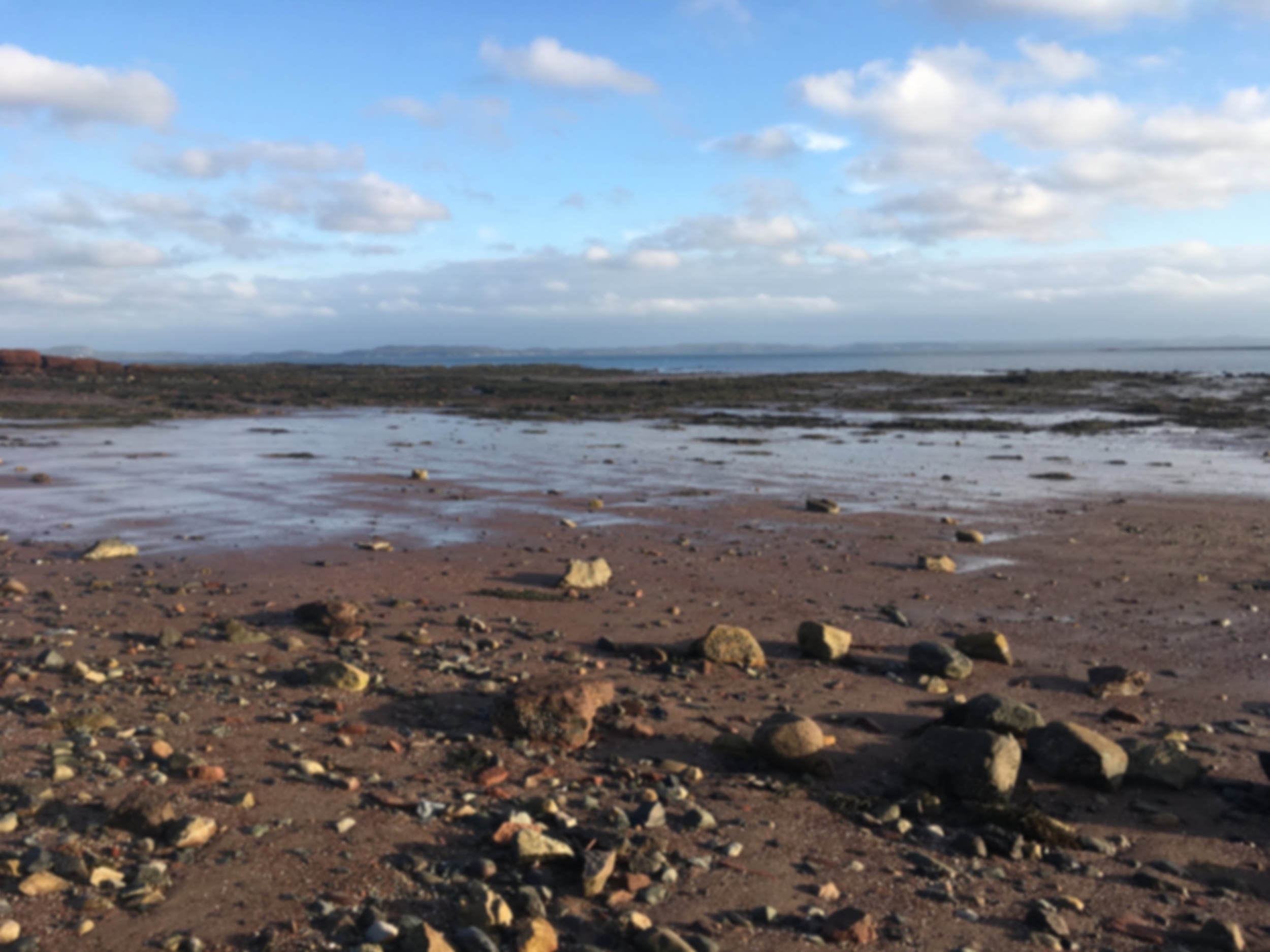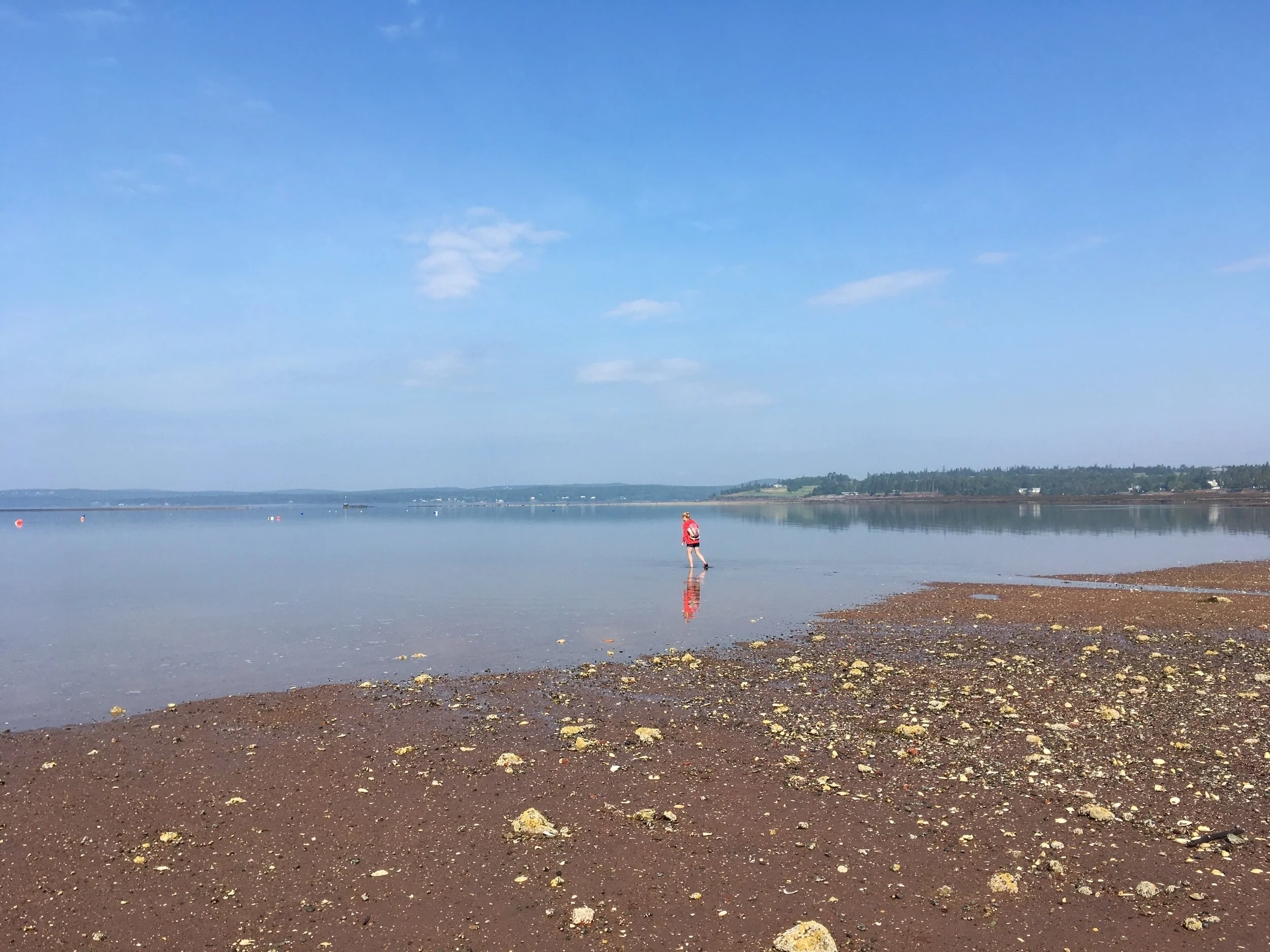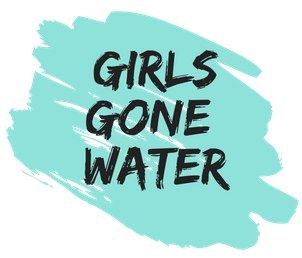
BY Irene Brueckner-Irwin
“I have a constant craving to be in, on, or under the water,” says Sondra.
This is apparent to me as I watch Sondra paddle ahead of me in our borrowed sea kayaks. She’s admiring the underwater forest of kelp and rockweed through the shallow, clear water in Bocabec Cove on the Bay of Fundy. It’s a burning hot July day and the cold saltwater dripping onto my legs from the paddle provides respite. Sondra’s curiosity sparks my own. I lean in closer to examine the dripping water and wonder who else is paying attention to such remote corners of the ocean.

The blue economy
As it turns out, lots of people are paying attention.
The Blue Economy is surfacing on the radar of governments, businesses, and other organizations on a global scale. Everyone is starting to talk about the ocean, whether it’s about harnessing untapped economic potential or finding solutions to climate change.
The WWF defines the Blue Economy as "a marine-based economy that:
1. provides social and economic benefits for current and future generations;
2. restores, protects and maintains the diversity, productivity, resilience, core functions, and intrinsic value of marine ecosystems;
3. is based on clean technologies, renewable energy, and circular material flows.”
At its simplest, the Blue Economy is an emerging concept that describes economic activities relating to the ocean. For some, it also implies sustainability and ocean stewardship. The intent is to put the ocean front-and-centre – to invest more in research and innovation, take advantage of an economy that hasn’t received its due attention, and solve the challenges facing our oceans.
And there are challenges.
Animals are eating plastics that are floating in the world’s oceans. Offshore oil and gas operations are spilling toxic substances, and fisheries are depleting. The oceans are warming and acidifying, and sea levels are rising. These issues impact life in the ocean but they also affect people and livelihoods.
But what is the Blue Economy, really?
High-level definitions are helpful, but they don’t capture the tangible stories of what the ocean means to people. How does it feel to be a part of the Blue Economy?

The ocean means different things to different people
For many, the Bay of Fundy is local. Connections to the bay manifest in the daily routines of many people within the communities here – perhaps a morning coffee on a veranda or a walk past the wharf with salt hanging in the air.
Sondra Eger spent the summer of 2018 travelling around the Bay of Fundy exploring how different communities use and relate to the water for her PhD research. Her goal was to understand what it takes to manage coastal and marine resources sustainably given the multitude of activities taking place on and in the water.
Setting out to learn about different perspectives and ecosystems around the bay, she participated in local activities and spoke with practitioners, researchers, and managers from the private sector, various government departments, and coastal communities. She volunteered with the Sipekne’katik First Nation at their annual Striped Bass Derby, visited a traditional fishing weir on the Minas Basin, and rafted a tidal bore on the Shubenacadie River.
Reflecting on these experiences, Sondra repeatedly mentions her time at the Bramber Weir (also known as the Marine Institute of Natural and Academic Science), an operation in both commercial fishing and scientific data collection. To Sondra, the weir represents a much-needed example of integrating local knowledge and Western science through collaborations with NGOs and academia, and public education.
Sondra tells me that sorting fish at the weir helped her appreciate the diversity of life here. Learning the names of local species and gaining a deeper understanding of this unique method of fishing at the beginning of her field season helped Sondra feel more equipped to continue her work over the following months. “I think it was a really important experience for me to have.”
Through her wide range of conversations over the season, Sondra took away many diverse ways of looking at the bay. “It was really clear to me after a while that people express what the ocean means to them very differently,” she reflects. “The ocean means different things for different people.”

The Bay of Fundy has incredible diversity
Biodiversity in the Bay of Fundy is extraordinary, thanks in part to a wide range of habitats, such as seagrass, corals, rocky areas, salt marshes, and mudflats. Whales, porpoises, seals, fish, invertebrates, and birds all gather here at various stages of their lives.
This diversity is well-represented at the Huntsman Marine Science Centre, where KatieAnne Rogers works as an aquarist. Mid-summer, I walk into the aquarium and I’m met by a flurry of activity – a public seal feeding, delighted children exploring different critters in the touch tanks, and a couple admiring the prehistoric Atlantic sturgeon. KatieAnne is bustling around to ensure operations are running smoothly.
KatieAnne tells me her favourite animals are the seals, but then quickly adds the ocean pouts and skates (they are personable). She’s enthusiastic about her job, which entails system maintenance, animal husbandry, public education, and customer service. She’s responsible for 50+ species in 18 tanks, feeding them and maintaining conditions like temperature, salinity, and oxygen. Most of all, she loves caring for the animals and watching them grow.
Another big part of her work is opening people’s eyes, she tells me. People visit the aquarium and have a hard time believing all these animals are native to the area. “They’re blown away when they realize all this stuff is in the Bay of Fundy,” she explains. When visitors take time to admire the creatures, they form emotional connections with the animals and become more considerate of the challenges facing the ocean.
A few days after we speak, KatieAnne contacts me to add an important detail: “I realized when you asked me what my favourite animals are, I forgot lobsters!”

Hard work is imperative
The lobster fishery is a mainstay of the Bay of Fundy economy. Lobster was once a species that helped supplement incomes from other fisheries, but now it’s the most economically important wild species in the bay. Dramatic increases in the number of lobsters on the ocean bottom, strong market prices, and more efficient technology have led to a major boom since the late 1990’s.
Sheena Young is a lobster buyer on Deer Island, New Brunswick, who comes from a fishing family with a deep-rooted local history. The first time I met Sheena was in 2016 while waiting in line to take the Deer Island ferry. She told me that visiting the island was a necessity when it came to understanding the fishery.
Two years later, I’m back on Deer Island learning about the lobster fishery. Sheena and I are sitting in the back room of the Boatique, a fishing supply store she and her sister recently opened together. I ask her to describe what it’s like to be part of opening day for the fall lobster fishing season every November.
“I will be at the wharf when the boats leave at 6 AM,” Sheena explains. Those who don’t go out fishing usually get together and have coffee as the boats depart. The fishermen steam out and then set and fish their traps. “You’re on the ground, you’re waiting by your phones, making sure everybody’s safe. That first day, until the last boat is home… everybody’s just waiting to see.”
Sometimes Sheena fishes the first day with her family, but she’ll start buying lobsters the following day. Her days begin around 5 AM and she’ll be home by midnight if she’s lucky. She meets incoming boats at scows, weighs the catch, and loads trucks waiting to transport the lobsters to storage or market. And she still has to prepare materials like crates and bait.
“You can plan to a point, but you have to always leave room for discrepancy,” Sheena says. “Eat when you can, sleep when you can…and carry on.”

Change is constant in the tides
“Not many people can adapt like a fisherman can adapt,” Sheena tells me. Fishing and buying are greatly influenced by time and weather, but also by the Bay of Fundy’s famous tides. Around Deer Island, twice a day the surface of the water rises and falls by 20 to 25 feet – a height difference taller than an adult giraffe.
Stories abound of people underestimating the tide. At their worst, people are caught and swept away. At their best, people gain a sense of awe for the dynamism of the ocean. Locals are constantly reminding visitors not to leave their belongings near the shoreline lest they be scooped up by the incoming tide.
Amanda Harrington, a sea kayak guide who grew up around the Bay of Fundy, knows the tides well. “My favourite thing when I’m guiding is definitely the look on people’s faces when the tide comes in and out during our lunch break because we’re only there for 20 minutes,” she says.
Amanda has also kayaked internationally. In New Zealand, she noticed differences from back home. There were dolphins, penguins, and birds she had never seen before. The taste of salt in her mouth wasn’t as persistent because of freshwater runoff from nearby rainforests. She also noticed that New Zealanders spoke more often about local cultures and lands while paddling.
These experiences shifted her perspective and made her more appreciative of her home. She realized that after guiding on the Bay of Fundy for seven years, she had grown accustomed to the massive tides. Upon returning home, she resolved to focus more on the cultures and unique features of Fundy while guiding.

Personal wellbeing depends on the water
The tides of Fundy also serve as a metaphor for the personal highs and lows that are experienced by those who live around the bay. Amanda’s intent to guide over the summer of 2018 was complicated by severe health challenges. Fresh air helped, but she ultimately made a tough decision to halt her professional kayaking and focus on her health.
“For me, not kayaking is almost like breaking up with your long-lost love,” she explains as we sit together in Fredericton, New Brunswick. “I feel claustrophobic in Fredericton. I’m not near the water.” Amanda felt lost immediately following her decision to stop guiding for the season: “It’s like a whole part of me was missing. Then I just had to figure out ways to distract myself or to not think about it.”
A large part of Amanda’s summer was spent in the hospital, but she still managed to get out for short last-minute paddles when she was feeling up to it. Her strong connection to the Bay of Fundy and the prospect of being back on the water gave her something to look forward to.
Amanda’s personal wellbeing was tested, but she overcame immense challenges and has since been properly diagnosed with a positive outlook for managing her health in the future

Sustainability?
Relationships with the water change with the triumphs and tribulations of people. To be part of the Blue Economy is to adapt. But is there a point where too much change compromises sustainability?
Many people worry that the lobster fishery is due for a bust, which would leave many rural communities vulnerable to socioeconomic woes – especially for younger generations.
As we sat together on Deer Island, I asked Sheena whether there are generational differences in the fishery. She hesitated before admitting her answer: “I fear for what could happen in these communities.”
Sheena comes from a generation that fished ‘poverty pots’, when lobster traps often came up empty. All fishermen knew what tough times meant. If one species declined in population or market price, fishermen could switch to different species while they waited in anticipation of a rebound. Livelihoods depended on a multi-species fishery.
Now, lobster is king. The cost of entering the fishery is high, and many bank loans are used to make the significant investments required to acquire a license, boat, and gear upgrades.
The implications are debated. Some people see the booming lobster industry as a sign that things area headed in the right direction. But others worry that bigger boats and better gear will eventually cause over-fishing, and there are concerns about over-capitalization. The fear is that the fishery will decline and cause significant fallout, which could result in external interests swooping in and buying out investments that were once rooted in local ownership.
Sheena wonders whether management can keep up with ecological and socioeconomic changes in the fishery. The federal government is responsible for fishery management and scientific research, but there have been many cases in Canada’s history where fisheries have been depleted. Reflecting on these cases, Sheena asks, “where were the managers?”

Culture, identity, and wellbeing are the threads
The southernmost tip of Deer Island is home to ‘Old Sow’, the largest tidal whirlpool in the Western Hemisphere. Many animals come to feed on nutrients that surface here due to tidal currents and upwellings. It’s common to see whales, porpoises, seals, birds, and boils of herring.
Brontë Thomas, a fisheries technician with the Peskotomuhkati First Nation, tells me about camping at a site on the edge of the island beside the Old Sow:
“I had a little pouch of tobacco with me and I offered it to the fire – giving thanks to the ancestors of the territory for having us. We saw so many amazing creatures while camping there, but the real treat came at night, just as the sun fell beyond the horizon. A beautiful minke whale approached the shore that our campsite was on. I heard the blows first, then I saw it… I had never been so close to a whale from the shore before and it was absolutely amazing.”
Brontë and I are having coffee together in St. Andrews, New Brunswick, and she explains to me the importance of water in the region. St. Andrews – or Qonaskamkuk (“the meeting place”) – is part of the traditional territory of the Peskotomuhkati Nation, which extends from the Lepreau River and into the modern-day United States. The Skutik River (also called the St. Croix River) is the lifeblood of the Nation. It empties into Passamaquoddy Bay, a ‘soup bowl’ of life-sustaining food that has been critical for the health of local people since time immemorial.
Brontë spent a large part of last summer in Halifax while enrolled in an ocean governance course. Halifax is a coastal city, but Brontë was missing her home in New Brunswick on the Fundy coast, where there are fewer distractions and more opportunities to be directly in nature. “[I] go down to the beach – I’m always the only person there – and there’s something about just being alone with those settings with the water… it’s extremely healing.”
We finish our coffees and I feel Brontë’s warmth radiating as she speaks: “I feel like I’m talking about the love of my life when I’m talking about that bay.” She’s not alone in her sentiments. When I ask each woman to describe her connection with the Bay of Fundy, each response is surprisingly aligned around culture, identity, love, and spirituality.

More than an under-tapped resource
Values embedded in culture, identity, and wellbeing thread these stories together.
These values are intangible and hard to define, but it’s clear that the Bay of Fundy fulfills fundamental human needs and is deeply connected to the surrounding cultures.
The Blue Economy is more than an under-tapped resource that can yield economic and social benefit if managed sustainably. For many, it’s life. The Peskotomuhkati Nation has been connected to the Bay of Fundy for at least the past 13,000 years, and people have long been adapting with the dynamic marine environment.
But despite our long history of change and adaptability, human activities are changing the oceans and earth faster than ever before. Renewed attention on marine places like the Bay of Fundy could help inspire more responsible ocean stewardship.
As I paddle my kayak between the cold Fundy waters and hot Maritime sun, I contemplate the Blue Economy and how it will contribute to ocean stewardship. And then it occurs to me that stories like these might be just as powerful in protecting this place as any emerging concept.
As Sheena said, “In the end, it’s just love and pride. I have so much pride in the Bay of Fundy – and I’m so proud of the men and women who call this place home.”
Published April 1, 2019

